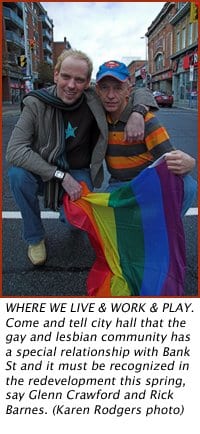The gay community has been taken for a ride by city hall’s planning process for Bank Street’s redevelopment this spring, charge community representatives. And they say now’s the time for the gay community to come out and insist on getting respect from city hall.
Plans for the spring 2008 redevelopment of Bank St between Laurier St and Somerset will be presented at a city Open House on Mar 18. But Capital Xtra has learned that the plans fail to include recognition of the gay community’s longstanding identification of Bank Street as the gay village.
Starting with a Feb 2006 Open House that was attended by an estimated 100 gays and lesbians, the community has called for recognition of a portion of Bank St as the city’s gay village. At that meeting, people called for signage, rainbow flags, banners and historic plaques to be incorporated into the infrastructure when Bank St is redecorated after a major dig to replace century old sewage lines.
Since then, a Facebook group of more than 500 members has formed. And Glenn Crawford and Rick Barnes (representing Pink Triangle Services) sat on a committee tasked with designing the new look for Bank St. Supporters of a village marched in the 2007 Pride Parade and more than 300 people have participated in a survey that asked about the boundaries of a village and what amenities people wanted to denote it.
There will be no such amenities under the plan to be shown to the public for comment on Tuesday.
“Nothing specific like that has been incorporated,” says Luke Foley, a city staffer and project manager. There are no plans for drop-down signs saying The Village. Or rainbow flags. Or banners. Or plaques. Or anything else that suggests that this is the gay village of Ottawa.
“I guess the comments and info we’re given, we look at the overall picture and ask if it’s for everyone,” says Foley.
The gay community’s ideas put forward by Crawford and Barnes had been carefully selected to ensure they would be inclusive and not create discomfort for non-gay residents and business owners.
Foley says that the plans include new banner holders on the street poles, but the Bank St BIA (the group representing the street merchants) has control over what banners or flags are raised. That “provides an opportunity” for the gay community to pressure the BIA into flying the rainbow flag, he says.
Foley also points to 90 bike racks that will be placed between Laurier and the Queensway. Some 30 designs by artists will accompany bike racks, so the gay community also has an opportunity to lobby for gay-positive art, says Foley.
Barnes and Crawford are both livid and disappointed by the results. Crawford attended three meetings of the design group at the encouragement of city hall, as well as meeting with the design consultants. He and Barnes say that at every step they were encouraged by representatives of other interest groups to believe that recognition of the gay community’s special relationship to Bank St was positive and inevitable.
“It’s a betrayal,” says Barnes, “leading us on to believe we had their support.
“We sat around the table with people who nodded at our ideas, giving us their support.”
Crawford points to positive language in both the consultant’s report and the report of the design committee that recognized the gay community’s relationship with Bank St and the need for signs and banners that made that clear.
“What’s the point of jumping through their hoops and giving our input if they’re not giving us a thing?” he asks. Is the hold-up at city hall or is the Bank St Business Improvement Area, representing merchants on the street, vetoing any proposed acknowledgment of the gay community, he wonders.
Crawford is designing a form for people to fill in at the Open House so that the community can demand that the design process go back to the drawing board and incorporate recognition of the gay village. He expects a heavy turnout of people demanding to be heard, especially after the promises that were made to the gay community at the Feb 2006 Open House.
And for those with an activist bent, Barnes is considering planning a small demonstration outside the meeting.
This city has to recognize that Bank St has a special connection to the gay community, says Barnes. “Our businesses are here, our groups. We live downtown.” It’s where we live and work and play.
“They can’t keep on disrespecting us,” he says.
Open House.
Tue, Mar 18. 5-8pm.
Centretown Community Health Centre.
420 Cooper St, room 208.
***
Gay-owned and gay-friendly businesses and community groups in downtown Ottawa:
- Use the + and – buttons on the upper left side to zoom in and out.

 Why you can trust Xtra
Why you can trust Xtra


